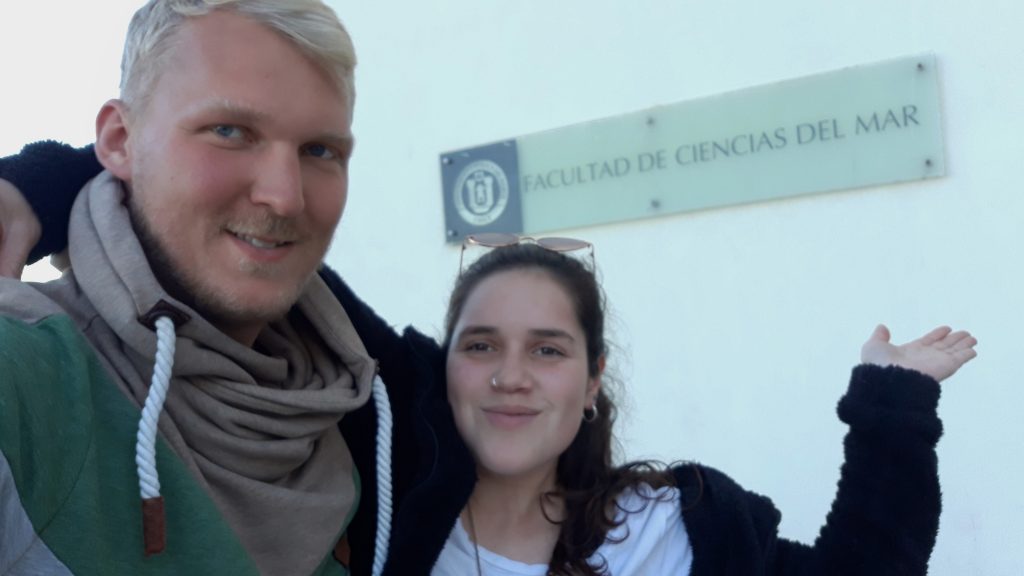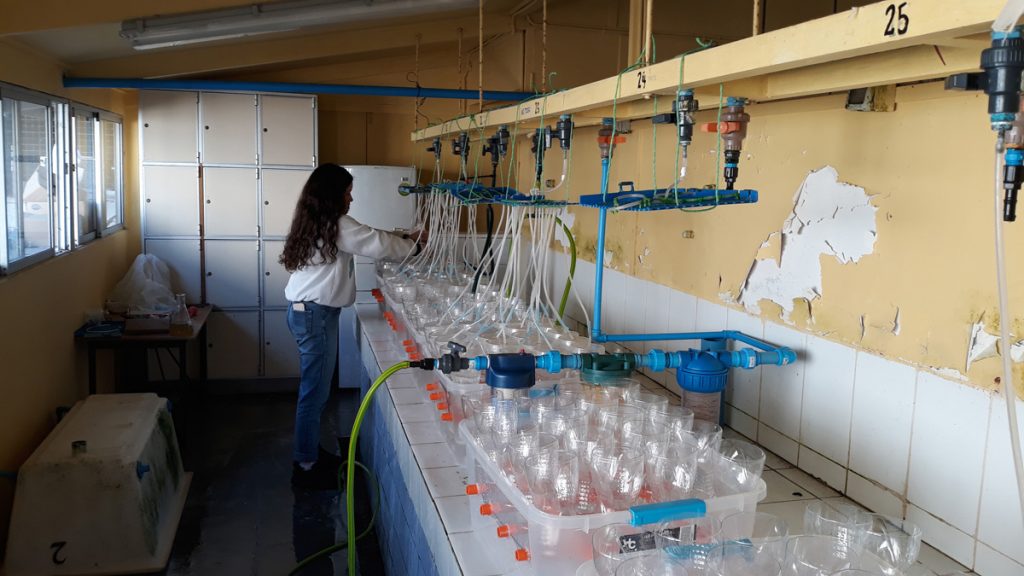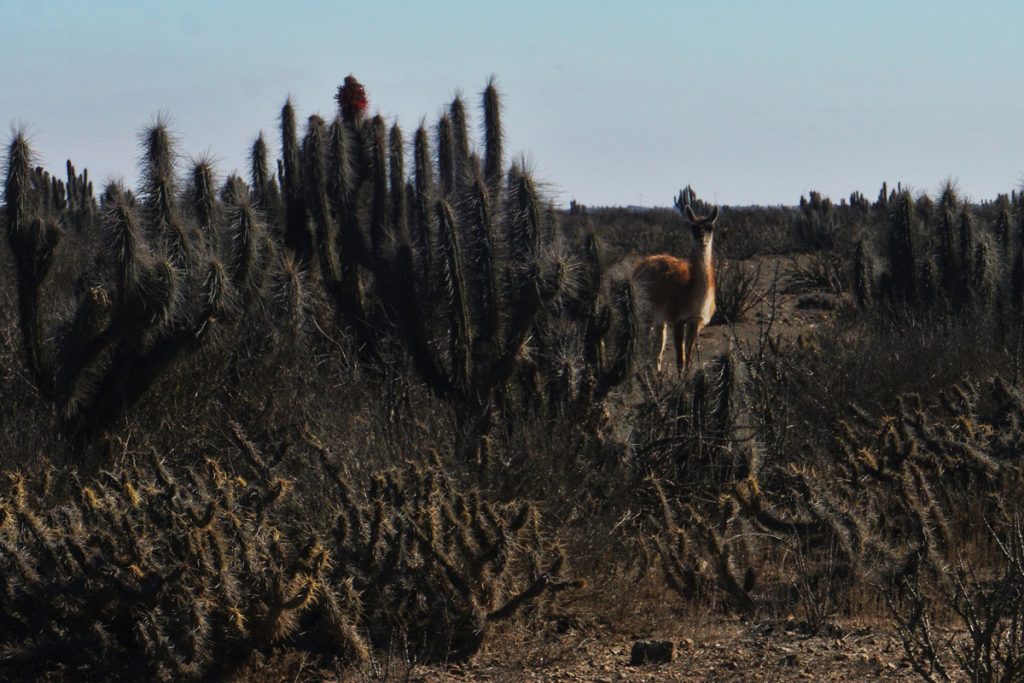Hola Cabr@s!
It’s Abril and Jonas calling from Chile. We are going to tell you about our first 6 months of our 9-month winter experience in Germany and Chile. We met in Kiel on the last days of the German winter and arrived in Chile at the beginning of winter in the southern hemisphere. But since we both enjoy dancing to the song: Nordisch by Nature by Fettes Brot in the lab, we know that we are made for this kind of climate (even though Abril is more “southisch” :D).
First, we are going to tell you a little about the city and the region of Coquimbo. The city harboring 200.000 inhabitants is located in the “Norte Chico”, the small north of Chile. The region is dry with low vegetation, but you can still find a lot of cacti and succulents. The winter here in Coquimbo is not the same as in the north of Germany, where you have very low temperatures, stormy winds, a lot of rain and sometimes even snow. In Coquimbo, the winter days are mostly grey and very foggy in the morning and in the night the temperatures drop very low. Nevertheless, rainfall is rare and can cause a lot of trouble when it happens. So, Jonas was a little surprised when all the classes were suspended as it started to rain moderately. However, he has the theory that the football match of the Chilean national team at the same day could have had something to do with it.
Next to Coquimbo is the Elqui Valley, that is known for its clear skies and high mountains. This is why many space observatories are based here. Also, the famous Chilean Pisco is produced here. It is a liquor made from white wine, usually consumed in the famous form of Pisco Sour (with egg white, lemon and a lot of sugar), or as the simpler “Piscola” (Pisco with cola) version. Another highlight of the region are the shores of Punta de Choros and Isla Damas. They are in an upwelling zone of nutrient rich deep water, which fertilizes the area and causes high abundances and diversity of species. This and the sheltered bays are the reasons why the shores are the perfect feeding and resting point for migrating whales on their way to the south. Moreover, also dolphins, sea lions, sea otters and Humboldt penguins can be observed here. More important for us were, however, the choritos (choro = Mussel), which we collected at these sites for our project – more of this will follow later.
We are working at the “Facultad de Ciencias del Mar” of the “Universidad Catolica del Norte” (UCN), which is located at the Herradura Bay of Coquimbo. Since it is a sheltered bay, the sea is really quiet and you can go for a swim, snorkel, or dive and can discover the bay with the kayak directly in front of the faculty. The faculty is well equipped and we have direct access to sea water supply and many different laboratories. The people working at the university are always friendly and willing to help us if we have questions. Special thanks go out to David Yañez, who saved us uncountable times. He really deserves the BBQ we promised him for his help 😉.

For the ones of you who do not already know this: The GAME project 2019 focusses on the comparison of the effects of microplastics and natural seston microparticles (like clay) on marine benthic filter feeders. For us, this is particularly interesting, because most studies in the field of microplastic research so far only focused on the effect of microplastic itself without comparing them to the effects of natural particles. Therefore, the questions how microplastic interacts with filter feeding animals and whether it is more harmful to them than natural particles remain mostly unanswered. So, this year’s GAME project aims at increasing our knowledge about the real impact of microplastics on the environment. In a preparation course in March, all the 9 GAME teams, who will work in Australia, Brazil, Chile, Cape Verde, Indonesia, Israel, Japan, Portugal and South Africa, gathered in Kiel to develop a common experimental design that will enable us to compare our results in the end on a global scale.
After we arrived in Chile with our Kiel-made plan, we were eager to get our set up ready and to start soon with the first preliminary experiments. But, of course, it’s not that easy. The first weeks were very intense and some unconventional ideas had to be put into action. Unforgettable was the transport of the 200 PET bottles – which we use as experimental containers – in a very tiny car. We almost had to leave Abril behind, since she did not fit into the car anymore. Nevertheless, we (both) made it back and established our set-up. We integrated a flow-through system in our experimental boxes to cool the bottles and installed a filter system for the seawater in the wet lab of the university. It took an entire week to build the system for all 140 experimental containers. Furthermore, we had to figure out how exactly we would measure our response variables. Always, two new problems evolved when one got solved. Moreover, other fundamental questions had to be discussed within the entire GAME group. This is quite complicated too, due to the time differences between the participating countries. However, after a very constructive skype conference, the main questions were answered and we were able to focus on our own specific problems in Chile again.




One of the biggest difficulties we faced was to find our test species Semimtilus algosus in the right size and quantities. Semimytilus algosus can grow up to a length of 5.4 cm, but usually we found them either very small (< 1 cm) or between 1 and 2 cm length, so we aimed for mussels of the average size of 1.5 cm. We chose this species, because it lives in the low intertidal and is therefore covered by water most of the time. It naturally faces a lot of suspended material because of the water movement. Since we want to compare the effects of natural microparticles and microplastics on marine benthic filter feeders, they are the ideal species for our experiment. Still, this specific habitat made it more difficult for us to find our “Semis”. You must know that in our part of Chile the waves are quite powerful and sometimes we got hit really hard. We always waited for spring-tides and a calm sea to search for our “Semis” at a beach nearby, but in the end, we had to drive two hours to the rich coast of Punta de Choros to find enough mussels of the right size.




Once we finished collecting the mussels, everything went very fast and we were able to start our main experiment at the 10th of June. We are really happy that everything we planned works quite well and that we are able to measure all of the variables we aimed for. And they are a lot. As we said before, we want to find out, if microplastics and natural microparticles have different effects on our mussels. For this, we worked out a schedule to measure the oxygen consumption, filtration rate, byssus production, size, wet weight, mobility every 3rd week and in the end, after 9 weeks, additionally the byssus strength, aggregation behavior and the body condition index of our mussels. Now, we are busy maintaining our system and taking care for our mussels every day, what is again quite a lot of work. Especially, during the weeks we measure our response variables, we barely see the sun.
Did we just mention the sun!? Yes right, apart from work we also witnessed one of the most spectacular phenomena which can be observed on planet earth. On the 2nd of July at 4:38 pm it suddenly got very dark in Coquimbo. We had the special luck to experience a total solar eclipse. Since it was a day of measurement as well, we started the lab work really early in the morning. Fortunately, the weather was perfect and there were no clouds in the sky. Just a few minutes before the magic happened, we – together with the two other internship students Frieda and Antony – hiked up the rocks behind the university and found the perfect spot to see the spectacle directly above the Pacific Ocean. The feeling you get when suddenly the temperature drops and everything darkens is very hard to describe. Within one second the sunlight disappears and you are able to see the corona of the sun around the shape of the moon. People started cheering and some even sang the Chilean national anthem, which was quite weird for us. However, basically, everyone was simply amazed by the moment and the 360-degrees sunrise around us. Sadly, the whole spectacle went by so fast that you could not really capture the moment. When the sun came back, many animals showed confused behavior and the birds made their circles over the rocks. For the rest of the day, everyone walked with a smile on the face.







Now in August, Chile is entering into spring time. The days are getting longer, flowers start blooming and it gets a little warmer. We are going to enjoy the rest of our time in the lab and, hopefully, in the end there’s some time left to see a little more of beautiful Chile. Until then, we will relish our paltas (avocados), completos (Chilean Hot Dogs), terremotos (a special cocktail with white wine and ice cream and also the name for a heavy earthquake) and of course, the sunsets over the pacific.

That’s it so far from Chile. Soon, we will come back to Germany and hopefully enjoy the last warm days of the year: After these 6 months of winter we are well prepared for the rainy German winter in Kiel.
Hasta luego! 😊

Danke für den detaillierten Einblick in euren chilenischen Winter und in eure Forschung! Euer Engagement und “Mission” sind deutlich spürbar! Ich habe sogar das meiste verstanden! 😊
Eine schöne und erfolgreiche Zeit noch!